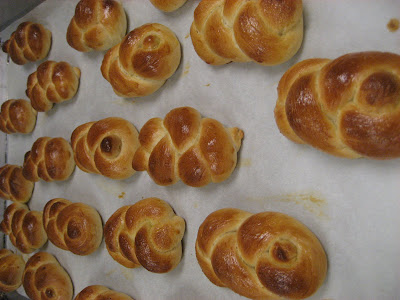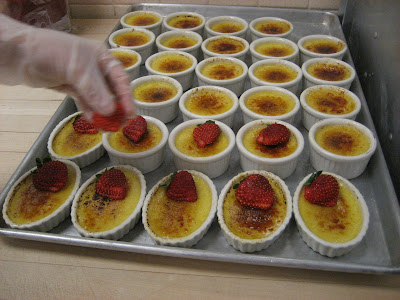 The rolls right out of the oven
The rolls right out of the oven Creme Brulee being garnished
Creme Brulee being garnished Though the photos do, not relate to the topic mousse, i just would like to bring the activities that happen in our kitchens.
Mousse
The name for this delicate dessert cmes froma french word that translates literally as frothy, foamy or light. To make a mousse, an aerator such as a whipped cream and or a meringue is folded into a base such as a fruit puree, vanilla sauce, cream or pudding, curd, sabayon, or pate a bombe. The base should be light and smooth so the aerator can be incorporated easily.
To make an egg-safe mousse, use pasteurized egg whites or a swiss or italian meringue. Stablizers such as gelatin may be used in variying amounts depending on the desired result. If a mousse is stablilized with gelatin, it will begin to set immediately, so prepare all molds, serving containers, and so forth before preparation.
Folding is the techinique used to combine a foamy mixture, such as meringue, shipped cream, or beaten egg whites, into a base mixture. The base is usually denser or firmer than the foam and will inevitably collapse the foam somewhat. Proper folding ensures that the foam loses as little volume as possible.
The base should be cooled if necessary befoe the foam is added. Add the foam to the base, rather than the other way around, and if using more than one foam, add the least stable one last. For example, if you are adding both a meringue and whipped cream, add the meringue first and then the cream.
Working quickly, add a small amount of the foam to the base to lighten it. Some pastry chefs add the foams in thrirds for the greater possible volume. Fold the foam in with a rubber spatula or other tool with a similar broad, flat surface. Using a cirular motion, gently run the spatula over the mixture, down and across the bottom of the bowl, and back up to the top again. Rotate the bowl as you work to mix the foam in evenly. Continue to fold the base and foam together until you have an even color and consistency, with no visible pockets of meringue, whipped cream.(Above topic taken from baking and pastry mastering the art and craft)
Maringues are devided into three types:
Common ratio 10oz sugar, 1#egg white
Swiss ratio 1#egg white, 1to2#sugar
Italian ratio 22oz sugar, 7oz liquid and then add common maringue.


